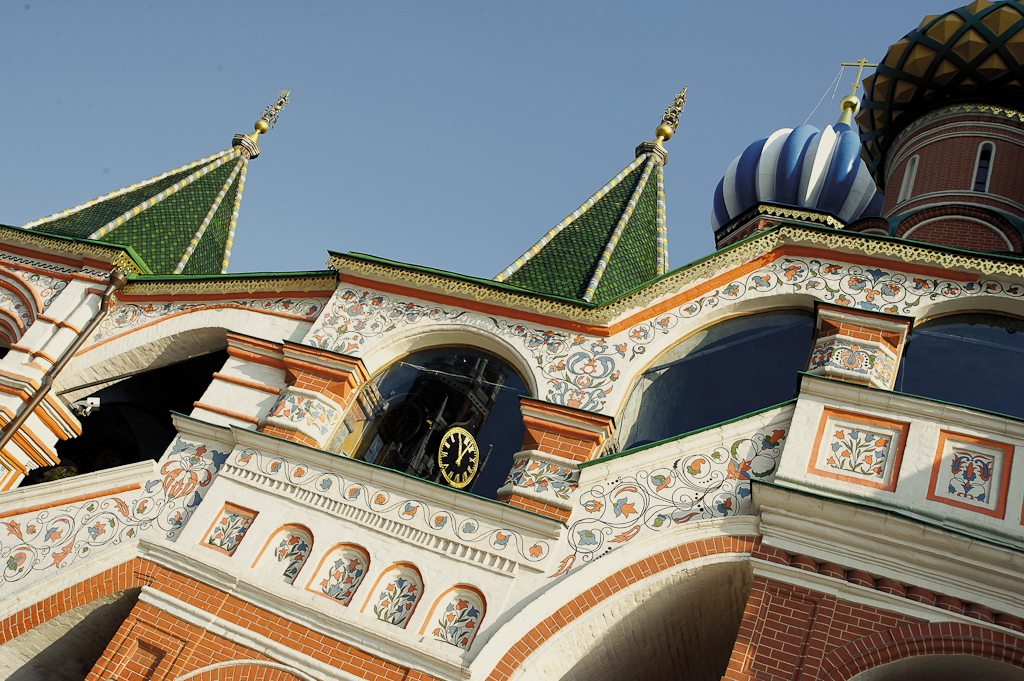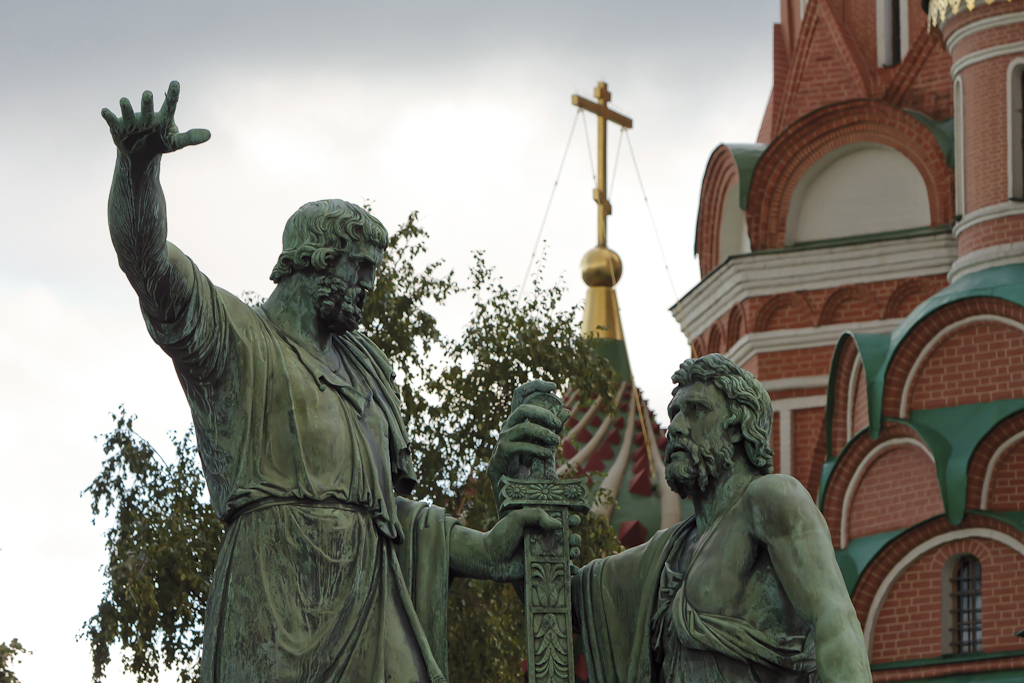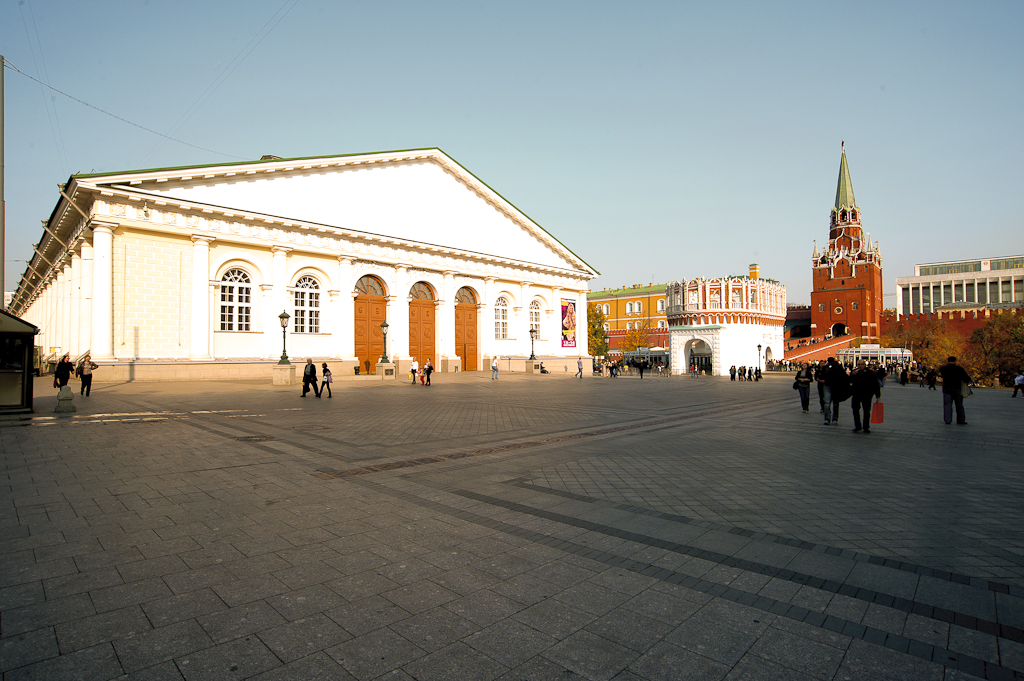The best place to start this walk is from Okhotny Ryad Metro Station. As you enter Manege Square, you can see the buildings of the State Historical Museum and the Iberian (Resurrection) Gate.
Mustering tourists toss coins over their shoulders trying to land them in the Kilometre Zero sign – a circle with a multi-pointed star ingrained into the stone pavement. The new belief has it that hitting the center of the sign would make one’ s dreams come true. Just keep in mind that the actual distance count starts from a different place. The true zero kilometre is located at the Main Post Office in Myasnitskaya Street.
In 1995 the monument to the best-known Russian Marshall Zhukov was unveiled in front of the State Historical Museum erected here more than a hundred and fifty years ago. The Zemsky Prikaz (municipal authority) had stood here to be replaced by the Main Pharmacy. It was in the building of the Zemsky Prikaz that the Moscow University was first open in 1755.
In Peter I times the building of the Austeria saloon was added to the Zemsky Prikaz where a customer reading Moscow Journal (the first Russian newspaper) was offered a free drink. Thus, the tzar imposed newspaper reading in Russia.
The Resurrection Gate is much older than the Historical Museum. It had received its name from the Monastery of Resurrection located nearby.
The gate was built as the main entrance into Kitai-gorod, the second fortress built in Moscow after the Kremlin. In the 1930s the gate was demolished to be restored to the ancient drafts a few years ago. The Chapel of the Iberian Icon of Our Lady stands nearby. The gate’ s second name Iberian is attributed to the chapel.

To the left stands the branch of the State Historical Museum. This building used to house the Moscow City Duma (municipal parliament) between 1892 and 1917 and the Lenin Museum from 1924 till 1993.
Through the arch of the Iberian Gate you enter Red Square. Its name was derived from the Old-Russian word “ red” meaning “ main”, “ beautiful”.
On the left you can see Kazan Cathedral which was built as a monument commemorating the liberation of Moscow from Polish invaders in 1612. The cathedral was rebuilt in 1993.
The building behind the cathedral is occupied by the Upper Trade Rows (GUM). It was erected more than one hundred years ago. Red Square had always been the venue of trade, thus its other name was Veliky Torg (Great Auction). GUM means not only numerous shops and cafes but also remarkable architecture. A skating-rink is set up in front of GUM every winter.
The opposite side of the square is dominated by the Cathedral of the Protection of Most Holy Theotokos on the Moat. Its name reminds of the stank dug out in the old times along the Kremlin wall where the Lenin’ s Tomb is presently located. After the great fire of 1812 the moat was filled during the reconstruction of the square to the design of Joseph (Osip) Bove. Most people refer to the cathedral as St. Basil’ s due to the name of one of its aisles. The cathedral was constructed on the order of the Russian tzar Ivan the Terrible in commemoration of his victories. The Cathedral is a UNESCO World Heritage site. At present it accommodates a museum which is worth visiting.

To your left is Lobnoye Mesto (Forehead Place, Place of Skulls). From this platform the tzars addressed muscovites, as well as “ukases” (tzar’s decrees) were announced.
In front of St. Basil’ s Cathedral stands the monument to the liberators of Moscow in 1612 – K. Minin and D. Pozharsky. It is the oldest sculptural monument in Moscow unveiled in 1818. The money for its construction was raised throughout the whole of Russia. Its original place was by the Upper Trade Rows, however in 1931 the monument was moved to a new location in order not to impede parades. The parades also caused the demolition of the Iberian Gate.
To the left is the most famous Kremlin tower – the Spasskaya (Savior) Tower. It was raised in 1491 by the Italian architect Pietro Antonio Solari, also known as the builder of the Kremlin Palace of Facets. Under the reign of the tzar Mikhail Fyodorovich, the tower was crowned with a tall hipped roof, and the icon of Spas Nerukotvorny (Devine Savior) was placed above the gate giving the name to the tower. One of the tower’ s attires is the famous clock crafted by the English clockmaker Christopher Galloway. The clock is over a century old. It is huge: the hour hand alone is three meters. The very first clock was installed on the tower already in the XVI century.

Take a walk downhill along Vassilyevsky Spusk (St. Basil’ s Descent) towards the Moskva River embankment.
The place is well-known among young Russians. Pop music shows are frequently staged here. The square appeared together with the construction of Big Moskvoretzky (Moskva River) Bridge. The bridge railing is adorned with images of the city’ s Soviet period coat of arms – a five-pointed star, a sickle, a hammer and the Freedom Obelisk. In 1993 the city has retrieved its original emblem with St. George the Victorious.
Turn to the right into the Kremlyovskaya (Kremlin) Embankment and take a walk along the wall of the ancient fortification.
Ahead is Big Stone Bridge. A wooden raft bridge which had been here from times immemorial was replaced with a bridge made of stone in the end of the XVII century. It was the first stone bridge across the Moskva River 170 meters long and 22 meters wide. The bridge had undergone several reconstructions. The present day bridge was erected in the 1930s with the length of 500 and the width of 40 meters.

At the corner tower called Vodovzvodnaya (Water Lifting Tower), turn right passing the Lower Alexandrovsky Garden towards the Borovitskaya Tower. According to the legend, its name was derived from a thick forest (bor) that grew on the Kremlin hill. The tower’ s gate opens the way inside the Kremlin for cars and pedestrian visitors of the Armory Chamber.
To the left you can clearly see famous Pashkov House. It was erected in the 1780s allegedly as per the design of the architect V. Bazhenov for captain-lieutenant P. Pashkov, who was the son of Peter the Great’ s batman. The edifice tops the steep Vagankovsky Hill. The grand entrance to the manor premises is from the Side-Street on the opposite side of the main faзade. For more than one hundred and fifty years the building has been occupied by a library – formerly Rumyantzev, with the present-day name of the Russian State Library. It was from the balustrade of this “ most beautiful Moscow edifice”, Pashkov House that Voland and Azazello gazed at the city of Moscow as described in the famous “ The Master and Margarita” novel by M. Bulgakov. Among the young this novel is one of the best read Soviet classics.
Proceed towards the Middle Alexandrovsky Garden. The garden was planted along the Kremlin wall in the 1820s on top of the Neglinka River, confined to a tube. It was here that Bulgakov’ s Margarita first met Azazello. On a warm day, the garden is full of youngsters, parents with kids and romantic couples.
Straight ahead is Troitsky (Trinity) Bridge, the oldest in Moscow. It leads to the Kremlin Troitskaya (Trinity) Tower. The bridge was erected in 1516 and was reconstructed on repeated occasions. Originally, it spanned the Neglinka River until it was put in a tube. Now the alley of the Alexandrovsky Garden runs underneath.
Trinity Bridge marks the beginning of the Upper Alexandrovsky Garden. As a reminder of the war with Napoleon the “ Ruins” Grotto was constructed here with the use of debris of houses destroyed during the invasion. A monument in a shape of an obelisk with Communism philosophers’ names stands opposite the grotto. This part of the garden accommodates the memorial of military glory with the Tomb of the Unknown Soldier and the Eternal Flame. It is here by the Tomb of the Unknown Soldier that Post No.1 of the Guard of Honor of the Kremlin Regiment is to be found. Changing of the Guard Ceremony takes place every hour.

The Alexandrovsky Garden offers a good view of the Manege, the structure erected by a Spanish architect Agustin de Betancourt on the order of the emperor Alexander I to commemorate the fifth anniversary of the victory over Napoleon. Contemporaries were astonished with the Manege’ s internal design. The roof spanned a huge space without a single internal support. Originally, the structure was used for military parades, but as of 1831 various exhibitions, ballroom parties and sports competitions had been held here. The present-day Manege is an exhibition hall.
In the 1990s an underground shopping center was built under Manege Square. Apart from numerous shops the place is full of various cafes offering a chance for snack and rest.
Alongside the trade centre, from the Alexandrovsky Garden, runs an artificial riverbed imitating the watercourse of the tubed Neglinka with numbers of fountains used by youngsters for a plunge on a hot summer day.
So, here we are back at the Historical Museum. Don’ t forget to take a careful look at the fence and the grating of the main entrance to the Alexandrovsky Garden. To your left towers the colossus of the Moskva Hotel. The building was erected in several stages. Stage 1 was accomplished in 1935 to the design of the architect A. Schusev. For many years the hotel was one of Moscow’ s brands. Not so long ago the old structure was demolished and replaced with a new building similar to the original.
Under the building of the hotel you can find the Moscow Archeology Museum. Its entrance is right opposite the Iberian Gate. It displays the piers of Voskresensky (Resurrection) Bridge built across the Neglinka River in the XVI – XVII centuries as well as old buried treasures and household utensils. All the objects on display in the museum were found during the excavation in the center of Moscow.
So, here we are back at Okhotny Ryad Metro Station – the starting and the terminal point of our tour.
